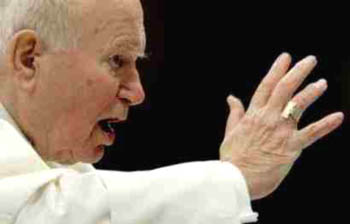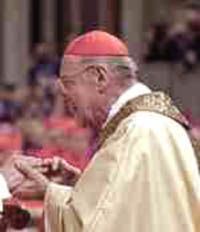 |
NEWS: November 24, 2004
Bird’s Eye View of the News
Atila Sinke Guimarães
RELICS TO SCHISMATICS - On November 27 John Paul II will deliver to the Schismatic patriarch of Constantinople Bartholomew I the relics of St. Gregory of Nazianzus (329-389) and of St. John Chrysostom (347-407). Both are Doctors of the Church and were Patriarchs of Constantinople before the Schism (1054). Such relics have been venerated in Rome since the 12th century (National Catholic Reporter, online edition, November 19, 2004).

JPII is scheduled to give the relics of St. John Chrysostom and St. Gregory Nazianzus to the Schismatic patriarch of Constatinople |
The handover of such inestimable relics takes us a step farther on the Progressivist agenda of John Paul II. The act supposes that the Schismatics - like the Catholics – would be good and upright in their doctrines. That is, JPII either doesn’t seriously think that the Schismatics (from Constantinople, Moscow, Athens or elsewhere) deny the dogmas of the Filioque – the Holy Ghost proceeds from the Father and the Son – as well as the dogmas of Pontifical Infallibility and the Immaculate Conception of Our Lady, or he doesn’t consider them as dogmas. Such relativism in face of the errors of false religions is part of what the Church calls Religious Indifferentism. It is included in the worst errors of the last centuries (Gregory XVI, Mirari vos DR 1613-4; Pius IX, Singulari quadam DR 1642; 1646-7; Quanto conficiamur, DR 1677-8; 1687; Syllabus, DR 1715-7; St. Pius X, Pascendi DR 2082).
Objectively, delivering such relics to Schismatics promotes a profanation of them. It was to avoid this profanation that the crusaders brought them to Rome after Constantinople entered into the Schism. The gesture of John Paul II is a denial of the Schism with its heresies; it is profanation and an insult to the memory of the crusaders.
SACRAMENTAL POLEMIC – The magazine Divinitas is the organ of the Pontifical Academy of Theology, one of the seven Pontifical Academies of the Holy See. It is published with the approval of Cardinal Francesco Marchisano. Its most recent issue featured articles by scholars in clear opposition to a three-year-old decision of the Vatican regarding the Holy Eucharist.

Card. Marchisano endorses articles critical of the Vatican decision on inter-communion -Vatican website photo |
The Vatican decision being contested was issued October 29, 2001; notwithstanding it was officially dated July 20, 2001. It presented new guidelines for admission to the Eucharist for the Catholic Chaldean Rite and the Assyrian Church of the East, which still professes Nestorianism. The norms were issued by the Pontifical Council for Christian Unity, in agreement with the Congregation for the Doctrine of Faith and the Congregation for the Oriental Churches.
In short, the decision approved inter-communion for a Catholic rite and a heretic one, and accepted the validity of the eucharistic prayer used by the Assyrians, even though it does not use the sacramental words of Eucharistic consecration – “This is My Body … This is My Blood” – instituted by Our Lord at the Last Supper (National Catholic Reporter, online edition, November 5, 2004). (For the Vatican document, click here).
Now, Divinitas came out against such a decision. German scholar David Berger, who signs one of the articles, is explicit:
"In none of the other sacraments does such clarity prevail as here: Christ Himself, according to the unanimous witness of Scripture and Tradition, personally and immediately decreed the matter and form of the Eucharist and Baptism. The Church thus has no authority to change something in the essential rites of these sacraments which is based on a divine ordinance."
Another scholar, Msgr. Brunero Gherardini, editor of Divinitas and professor at the Lateran University, published five arguments against the validity of the Assyrian eucharistic formula:
1. "Whoever presumes to celebrate the Eucharist by silencing or modifying the words used by Christ in the moment of institution performs not an act of devotion to Christ, but rather its contrary.
2. "That Christ could have consecrated in different ways than the one which is witnessed to by the sources of the New Testament, is not in discussion; but still less can it be discussed, or placed in the shadow of doubt, the lone way in which He himself [consecrated].
3. "This same, lone way is expressed in the words of Institution; 'This is My Body,' 'This is My Blood,' the one form of the Eucharistic sacrament; if one prescinds from [omits] that, or substitutes or substantially modifies it, the sacrament does not exist.
4. "This is deduced also from the command with which Christ provides for the actualization of what He did and how He did it.
5. "It follows that the celebrant consecrates the bread and wine solely with the words used by Christ, and in no other way; and, further, that solely one who within the sacred rite pronounces precisely those words in fact consecrates" (apud National Catholic Reporter, ibid.)
In another words, the members of the Pontifical Academy of Theology are telling the members of the three Roman Dicasteries, and also John Paul II who approved the document, that there is no true Eucharist in the Assyrian church, and that the Vatican decision of three years ago is invalid (heretical?).
My warmest congratulations to those brave theologians!
GOOD APPRAISAL, BAD INTERPRETATION – Normally my positions are the antipode of those of Fr. Andrew Greeley. But I agree with some points of his appraisal on the present day situation of the Catholic Church. In a book review, he wrote:
“Not since the early Middle Ages has the Catholic Church seemed so amorphous, formless, and anomic. …. The introduction by the Council fathers of the possibility of change in the Church lead to the dissolution of the Counter-Reformation, the anti-revolutionary structures of the 19th century, and the anti-Modernism of the early 20th century. It is not surprising that the result has been chaos and confusion among Catholics” (The Tablet, November 13, 2004, p. 22).
Where we still differ is in the interpretation. He imagines that this crisis is due to the incomplete application of the Council reforms. Quite the opposite, I think that it is directly because Vatican II was accepted and its reforms were applied. A bad tree that produced bad fruits.


Related Topics of Interest
 The Hand-Over of the Icon of Kazan The Hand-Over of the Icon of Kazan
 Kazan, the End of the Story Kazan, the End of the Story
 Pagan Sects Worship False Gods in Catholic Churches in Assisi Pagan Sects Worship False Gods in Catholic Churches in Assisi

|
News | Home | Books | CDs | Search | Contact Us | Donate

© 2002- Tradition in Action, Inc. All Rights Reserved
|
 |
|